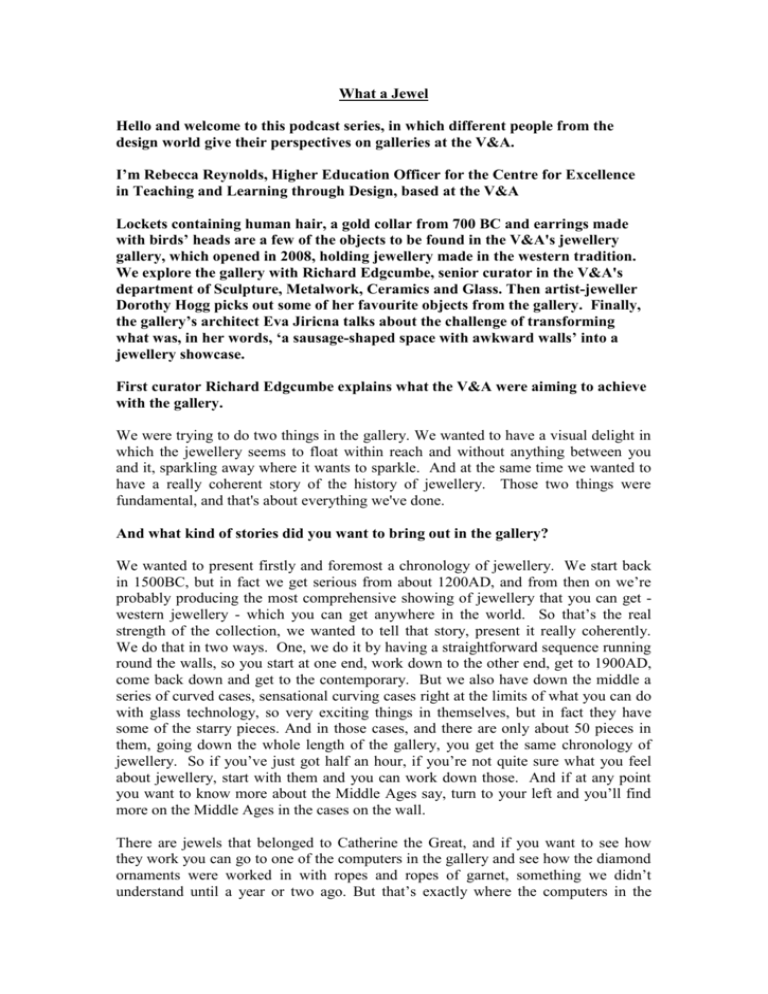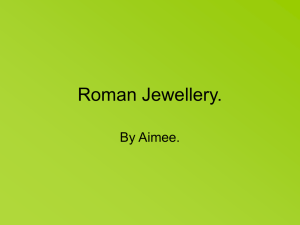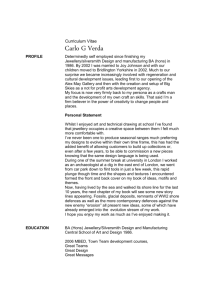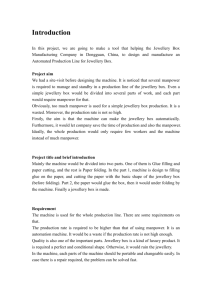Jewellery gallery podcast
advertisement

What a Jewel Hello and welcome to this podcast series, in which different people from the design world give their perspectives on galleries at the V&A. I’m Rebecca Reynolds, Higher Education Officer for the Centre for Excellence in Teaching and Learning through Design, based at the V&A Lockets containing human hair, a gold collar from 700 BC and earrings made with birds’ heads are a few of the objects to be found in the V&A's jewellery gallery, which opened in 2008, holding jewellery made in the western tradition. We explore the gallery with Richard Edgcumbe, senior curator in the V&A's department of Sculpture, Metalwork, Ceramics and Glass. Then artist-jeweller Dorothy Hogg picks out some of her favourite objects from the gallery. Finally, the gallery’s architect Eva Jiricna talks about the challenge of transforming what was, in her words, ‘a sausage-shaped space with awkward walls’ into a jewellery showcase. First curator Richard Edgcumbe explains what the V&A were aiming to achieve with the gallery. We were trying to do two things in the gallery. We wanted to have a visual delight in which the jewellery seems to float within reach and without anything between you and it, sparkling away where it wants to sparkle. And at the same time we wanted to have a really coherent story of the history of jewellery. Those two things were fundamental, and that's about everything we've done. And what kind of stories did you want to bring out in the gallery? We wanted to present firstly and foremost a chronology of jewellery. We start back in 1500BC, but in fact we get serious from about 1200AD, and from then on we’re probably producing the most comprehensive showing of jewellery that you can get western jewellery - which you can get anywhere in the world. So that’s the real strength of the collection, we wanted to tell that story, present it really coherently. We do that in two ways. One, we do it by having a straightforward sequence running round the walls, so you start at one end, work down to the other end, get to 1900AD, come back down and get to the contemporary. But we also have down the middle a series of curved cases, sensational curving cases right at the limits of what you can do with glass technology, so very exciting things in themselves, but in fact they have some of the starry pieces. And in those cases, and there are only about 50 pieces in them, going down the whole length of the gallery, you get the same chronology of jewellery. So if you’ve just got half an hour, if you’re not quite sure what you feel about jewellery, start with them and you can work down those. And if at any point you want to know more about the Middle Ages say, turn to your left and you’ll find more on the Middle Ages in the cases on the wall. There are jewels that belonged to Catherine the Great, and if you want to see how they work you can go to one of the computers in the gallery and see how the diamond ornaments were worked in with ropes and ropes of garnet, something we didn’t understand until a year or two ago. But that’s exactly where the computers in the gallery really help you. Equally, the computers show you the backs of every jewel. And of course the people making the jewellery are the heroes of the gallery just as much as… more than really, more than the people who commission the stuff. So it’s fantastic to have Catherine the Great, its fantastic to have Elizabeth I, but it’s also fantastic to have the tremendous products of craftsmen through the ages. Jeweller Dorothy Hogg was artist in residence at the V&A for six months. I walked around the gallery with her, looking at some of the pieces. Are there any particular pieces you'd pick out of the gallery as being particular favourites? Yes, there's a beautiful necklace by a lady called Sah Oved, who was born in 1900 and it's called Life Began in Water and that in itself is quite unusual. It's made of various metals, gold, silver, there's agates, jasper and aquamarines. But the agates have inclusions which look like the beginnings of fish and I'm sure that's how she would have got the title - sitting in her workshop, looking through her packets of stones and passing them through her hands and thinking what could I make with this, and the concept would develop. You mentioned this 1850 bodice ornament and looking at it what really attracts me is that it seems to be trembling as you look at it, and that makes the diamonds shine in different ways. Yes, this is an absolutely huge bodice ornament covered in diamonds and there are little clusters of flowers, which are made on to springs so that as the person moved, these sections would tremble and catch the light. It's called tremblant, using a French word. And you're pulling open a drawer at the side of this interactive display on the top floor. Yes, I think people could easily miss this but this is a complete treasure. There are a number of drawers and inside the one I'm looking at, I'm looking at things which would be affected by the light, the hair jewellery in here, where human hair was incorporated into pieces of jewellery. And there's one here where the hair's formed into a kind of a corn sheaf held together with some kind of jewels and plaited hair around it. Yes, it's probably a locket, maybe inside is a photograph of the person whose hair it was, the deceased person, that makes it all very sad, doesn't it? And then in the third drawer down we have some darker coloured jewellery here. Yes, what we're looking at here is tortoise shell that was inlaid with precious metal, it's called piqué work. And obviously we would not use tortoise shell now, but actually when I was a jeweller starting off in the 60s, we were, we didn't think it was not okay to use natural materials like these, obviously we know much better now but it just gives you an indication of the sort of naivety of the time. They're really beautiful brown pieces, tortoiseshell, little delicate traceries of gold. And the way they did it was to boil the tortoiseshell, make the delicate lattice work of gold and then press it in while the tortoiseshell was soft, let it cool down, dry out and it would clamp the gold in place. And this is a drawer full of jet jewellery. Yes, Queen Victoria was in mourning for such a long time everybody wore black jewellery for ages and jet is a natural fossilised coal-like material, so it's black and it's shiny and it comes from Whitby in Yorkshire mainly. And they were big factories in Whitby where they made a lot of jet jewellery, so it's all black and it's carved. And for example one I'm looking at here is a pendant piece with Lily of the Valley carved into it, and there are other pieces with portrait heads and sentimental pieces with hands holding things, it's very interesting, it's quite fragile. Lastly, I talked to architect Eva Jiricna about designing the gallery space and displays. Eva, can you tell me what your role was in the design of the Gallery? As an architect the first issue is how you deal with the space, and when we got the Gallery the Gallery was one tall little sausage, if I may say so, with very awkward walls, a very ugly ceiling and two doors, one for the entry and one for the exit. We knew that we were going to display about 4800 pieces of jewellery, and we knew there was not enough space on the walls to do so, so we knew immediately that we needed a mezzanine floor. Of course architecture only lives and is visible when you do the right lighting, and that was the most tricky part of the scheme because some of the objects have to have very limited lighting which means sometimes less than 50 lux. Some objects like modern jewellery can take any light and doesn’t sparkle unless you give it really a substantial amount of sparkle. Diamonds need different lighting than gold, some of the precious stones that visitors can see now plenty of also need special lighting. So to resolve the lighting - I think that was the most difficult task I have ever experienced in my architectural practice or my architectural life. Of course the next task was what the space was going to look like. The Gallery is part of a Victorian building, and of course it was a space which was completely devastated by all the previous conversions. So we wanted to give back something which would give you the basic feeling of being a natural part of that Victorian fabric, of the Victorian idea, of the Victorian feeling. And so we selected a colour which was very much a Victorian colour, which is dark red, which is very close to black. But still it gives you the softness because of course when you display the jewellery and when you have such limited lighting conditions, you try to put it on a black background because otherwise you will see all the shadows. And so this softness of red in connection with the dark black matt surfaces of the other boards, if you call it that way, just gives us a slightly softer impression, which to my mind feels better with the Victorian building. Also I think we had an opportunity to put a very short history of jewellery into the staircases and what those staircases should look like. It was a question which lasted for a couple of years to be resolved. We had an opportunity to work with extremely bright and capable people who made the glass turn in all kinds of directions and I have never seen such a perfection in production of the glass which is three dimensional rather than just a flat piece of a display cabinet. You’ve come to the end of this podcast; thanks very much for listening. Other podcasts in this series look at the Silver Galleries, the British Galleries and the Cast Courts.









